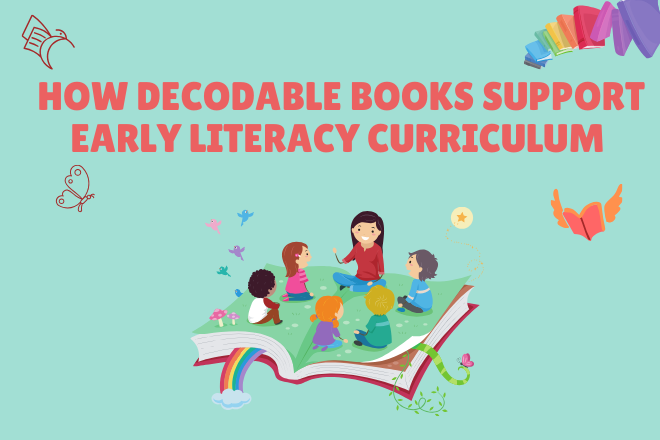How Decodable Books Support Early Literacy Curriculum
Decodable books play a crucial role in supporting early literacy curriculum, especially in the context of phonics instruction. They provide a foundation for phonics mastery, reading fluency, and reading comprehension among early learners.
In this blog, we’ll look at how decodable books support early literacy curriculum and literacy development for young readers.
Phonics Reinforcement
Phonics is a major part of reading, providing the foundation for decoding words. It helps young readers recognize words and grasp their pronunciations.
Decodable books are designed to follow a specific phonics progression with a focus on a sound-symbol relationship allowing children to practice applying the sound-letter relationships in a supervised environment.
For example, introducing a class of kindergarteners to vowel sounds.
By integrating decodable books into the phonics lesson, the teacher can introduce students to simple sentences that use each vowel sound. When students repeatedly see these words and practice sounding them out, they solidify their understanding of the newly learned phonics concepts.
Building Decoding Skills
Unlike traditional children's books with diverse vocabulary, decodable books contain words that strictly follow specific phonics rules children have recently learned.
This allows them to gradually apply those rules in a supervised environment, without getting overwhelmed by numerous unfamiliar sound-letter combinations.
The simple sentence structures and short words used in decodable books allow early learners to focus their skills on learning to break down words into individual sounds and combine sounds into whole words. This strengthens their phonics knowledge and is a crucial foundation for developing decoding skills.
Comprehension Support
Comprehension is a major part of reading and literacy, especially among young learners, and can sometimes be difficult for young learners.
However, decodable books use controlled vocabulary, texts that have a handful of words used repeatedly. This allows students to focus on understanding the content of specific sounds and letter combinations without being overwhelmed with too many words.
When students focus and practice a limited number of words they can concentrate on grasping the meaning of the text and making connections between the decoded words and the overall message of the book.
Systematic Progression
Decodable books are often designed in a sequential and organized manner, with increasing phonics difficulty levels. The initial levels may introduce simple phonics concepts like short vowel sounds, followed by an introduction of early learners to consonant blends.
As students progress through the various levels, new and more complex sounds can gradually be introduced, building upon the previously learned skills. This means students encounter words they can decode using their newly acquired knowledge, reinforcing their understanding and promoting practice. This gradual increase in difficulty levels helps support students' individual needs, challenges students appropriately, and builds essential reading skills progressively.
Increased Reading Confidence
Decodable books are designed to be readable based on a child's current phonics knowledge. Successfully decoding words within the context of decodable books plays a significant role in boosting reading confidence among early learners.
When they experience a high rate of success in decoding words, this builds their confidence and motivation to continue reading. This confidence is crucial for fostering a positive attitude toward reading and encouraging students to tackle more challenging texts.
Meeting Individual Needs
Students learn at different paces and in different styles. Part of a proper literacy curriculum is accounting for the reading styles and different needs of young learners.
Decodable books can be chosen or designed to cater to the diverse needs of students, this allows each student to progress at their own pace and receive appropriate learning challenges.
For example, some students are more visual learners and need books that integrate visual supports like pictures, color coding, or symbol representations. While others might be good with longer texts and grasping more complex sentences quickly.
Overall, decodable books are valuable tools for educators to customize the learning experience to meet individual student needs and build successful readers.

